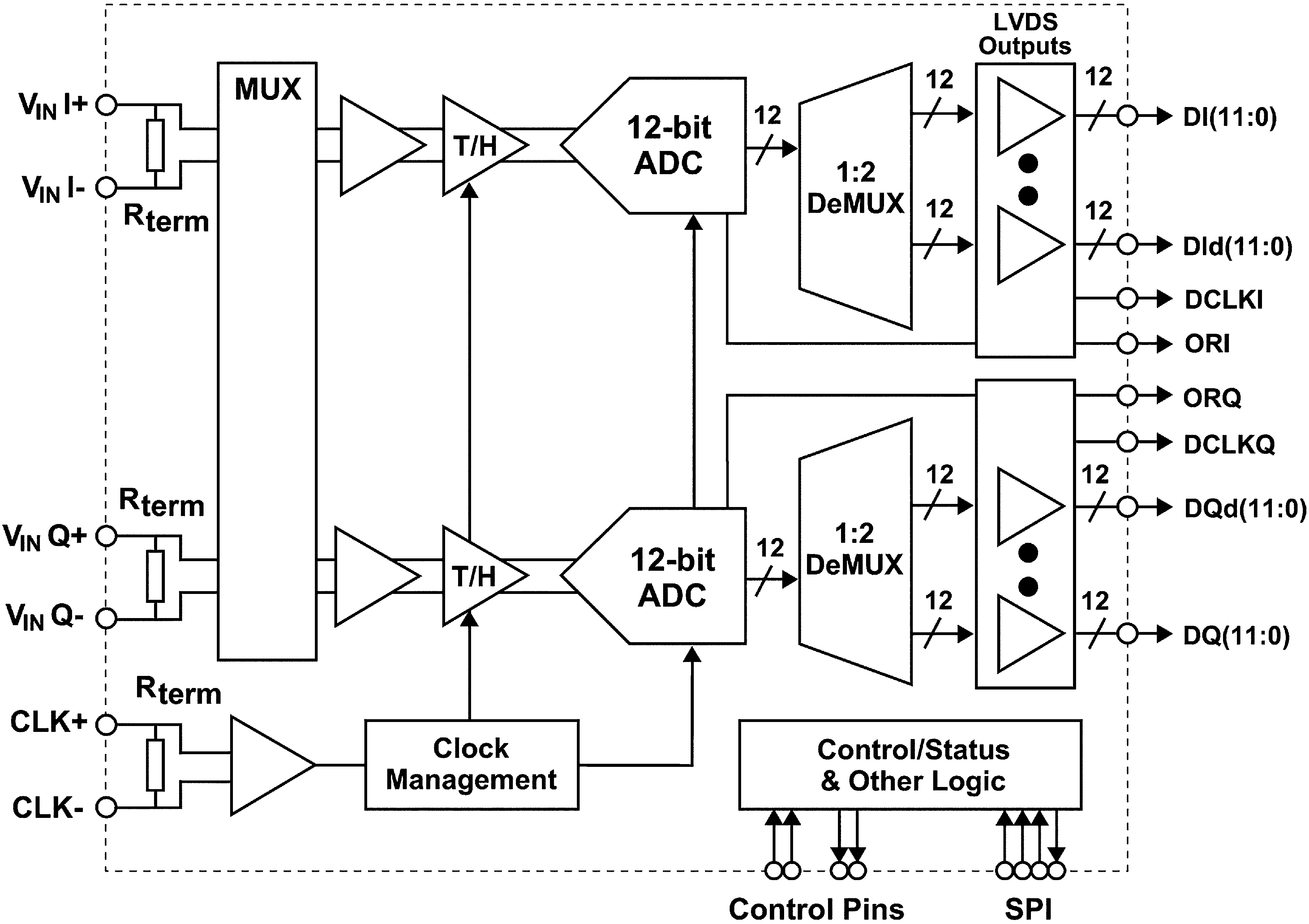SNAS500Q May 2010 – May 2017 ADC12D1800
PRODUCTION DATA.
- 1 Device Overview
- 2 Revision History
- 3 Pin Configuration and Functions
-
4 Specifications
- 4.1 Absolute Maximum Ratings
- 4.2 ESD Ratings
- 4.3 Recommended Operating Conditions
- 4.4 Thermal Information
- 4.5 Converter Electrical Characteristics: Static Converter Characteristics
- 4.6 Converter Electrical Characteristics: Dynamic Converter Characteristics
- 4.7 Converter Electrical Characteristics: Analog Input and Output and Reference Characteristics
- 4.8 Converter Electrical Characteristics: I-Channel to Q-Channel Characteristics
- 4.9 Converter Electrical Characteristics: Sampling Clock Characteristics
- 4.10 Converter Electrical Characteristics: AutoSync Feature Characteristics
- 4.11 Converter Electrical Characteristics: Digital Control and Output Pin Characteristics
- 4.12 Converter Electrical Characteristics: Power Supply Characteristics
- 4.13 Converter Electrical Characteristics: AC Electrical Characteristics
- 4.14 Converter Timing Requirements: Serial Port Interface
- 4.15 Converter Switching Characteristics: Calibration
- 4.16 Typical Characteristics
-
5 Detailed Description
- 5.1 Overview
- 5.2 Functional Block Diagram
- 5.3 Feature Description
- 5.4 Device Functional Modes
- 5.5
Programming
- 5.5.1
Control Modes
- 5.5.1.1
Non-Extended Control Mode
- 5.5.1.1.1 Dual Edge Sampling Pin (DES)
- 5.5.1.1.2 Non-Demultiplexed Mode Pin (NDM)
- 5.5.1.1.3 Dual Data Rate Phase Pin (DDRPh)
- 5.5.1.1.4 Calibration Pin (CAL)
- 5.5.1.1.5 Calibration Delay Pin (CalDly)
- 5.5.1.1.6 Power Down I-channel Pin (PDI)
- 5.5.1.1.7 Power Down Q-channel Pin (PDQ)
- 5.5.1.1.8 Test Pattern Mode Pin (TPM)
- 5.5.1.1.9 Full-Scale Input Range Pin (FSR)
- 5.5.1.1.10 AC/DC-Coupled Mode Pin (VCMO)
- 5.5.1.1.11 LVDS Output Common-mode Pin (VBG)
- 5.5.1.2 Extended Control Mode
- 5.5.1.1
Non-Extended Control Mode
- 5.5.1
Control Modes
- 5.6 Register Maps
- 6 Application and Implementation
- 7 Power Supply Recommendations
- 8 Layout
- 9 Device and Documentation Support
- 10Mechanical, Packaging, and Orderable Information
Package Options
Mechanical Data (Package|Pins)
- NXA|292
Thermal pad, mechanical data (Package|Pins)
Orderable Information
1 Device Overview
1.1 Features
- Configurable to Either 3.6 GSPS Interleaved or 1.8 GSPS Dual ADC
- Pin-Compatible with ADC10D1000/1500 and ADC12D1000/1600
- Internally Terminated, Buffered, Differential Analog Inputs
- Interleaved Timing Automatic and Manual Skew Adjust
- Test Patterns at Output for System Debug
- Programmable 15-bit Gain and 12-bit Plus Sign Offset
- Programmable tAD Adjust Feature
- 1:1 Non-Demuxed or 1:2 Demuxed LVDS Outputs
- AutoSync Feature for Multi-Chip Systems
- Single 1.9-V ± 0.1-V Power Supply
- Key Specifications
- Resolution: 12 Bits
- Interleaved 3.6 GSPS ADC
- Noise Floor Density –153.5 dBm/Hz (typ)
- IMD3 –61 dBFS (typ)
- Noise Power Ratio 48.5 dB (typ)
- Power 4.4 W (typ)
- Full Power Bandwidth 1.75 GHz (typ)
- Dual 1.8 GSPS ADC, Fin = 125MHz
- ENOB: 9.4 (typ)
- SNR 58.5 dB (typ)
- SFDR 73 dBc (typ)
- Power 4.4 W (typ)
- Full Power Bandwidth 2.8 GHz (typ)
1.2 Applications
- Wideband Communications
- Data Acquisition Systems
- RADAR/LIDAR
- Set-top Box
- Consumer RF
- Software Defined Radio
1.3 Description
The 12-bit, 3.6 GSPS ADC12D1800 is the latest advance in TI's Ultra-High-Speed ADC family and builds upon the features, architecture and functionality of the 10-bit GHz family of ADCs.
The ADC12D1800 provides a flexible LVDS interface which has multiple SPI programmable options to facilitate board design and FPGA/ASIC data capture. The LVDS outputs are compatible with IEEE 1596.3-1996 and supports programmable common mode voltage.
The product is packaged in a leaded or lead-free 292-ball thermally enhanced BGA package over the rated industrial temperature range of –40°C to +85°C.
To achieve full rated performance for fCLK > 1.6 GHz, write the maximum power settings one time to Register 6h through the serial interface; see Section 5.6.1 for more information.
Device Information(1)
| PART NUMBER | PACKAGE | BODY SIZE (NOM) |
|---|---|---|
| ADC12D1800 | BGA (292) | 27.00 mm × 27.00 mm |
1.4 Functional Block Diagram
 Figure 1-1 Functional Block Diagram
Figure 1-1 Functional Block Diagram